A Critical Review of UK Government's Approaches to Health Inequalities
VerifiedAdded on 2023/06/16
|9
|2524
|461
Essay
AI Summary
This essay examines the pressing issue of health inequalities in the UK, highlighting the unfair, avoidable, and systematic differences in health outcomes experienced by various population groups. It delves into the socio-economic, geographical, and ethnic disparities that contribute to these inequalities, particularly focusing on differences in life expectancy and access to healthcare services. The essay then analyzes the UK government's approaches to tackling these inequalities, including the Equality Data Programme, the role of the Social Mobility Commission, and initiatives within the NHS Long Term Plan. These measures aim to address the root causes of inequalities, break down barriers to social mobility, and improve health outcomes for marginalized communities. The essay concludes that while progress has been made, sustained and measurable actions are crucial to ensure a healthier and more equitable future for all residents of the UK, and stresses that health inequalities are not inevitable, and the government should take regular measures to tackle these situations so that people could live a happy and healthy life.
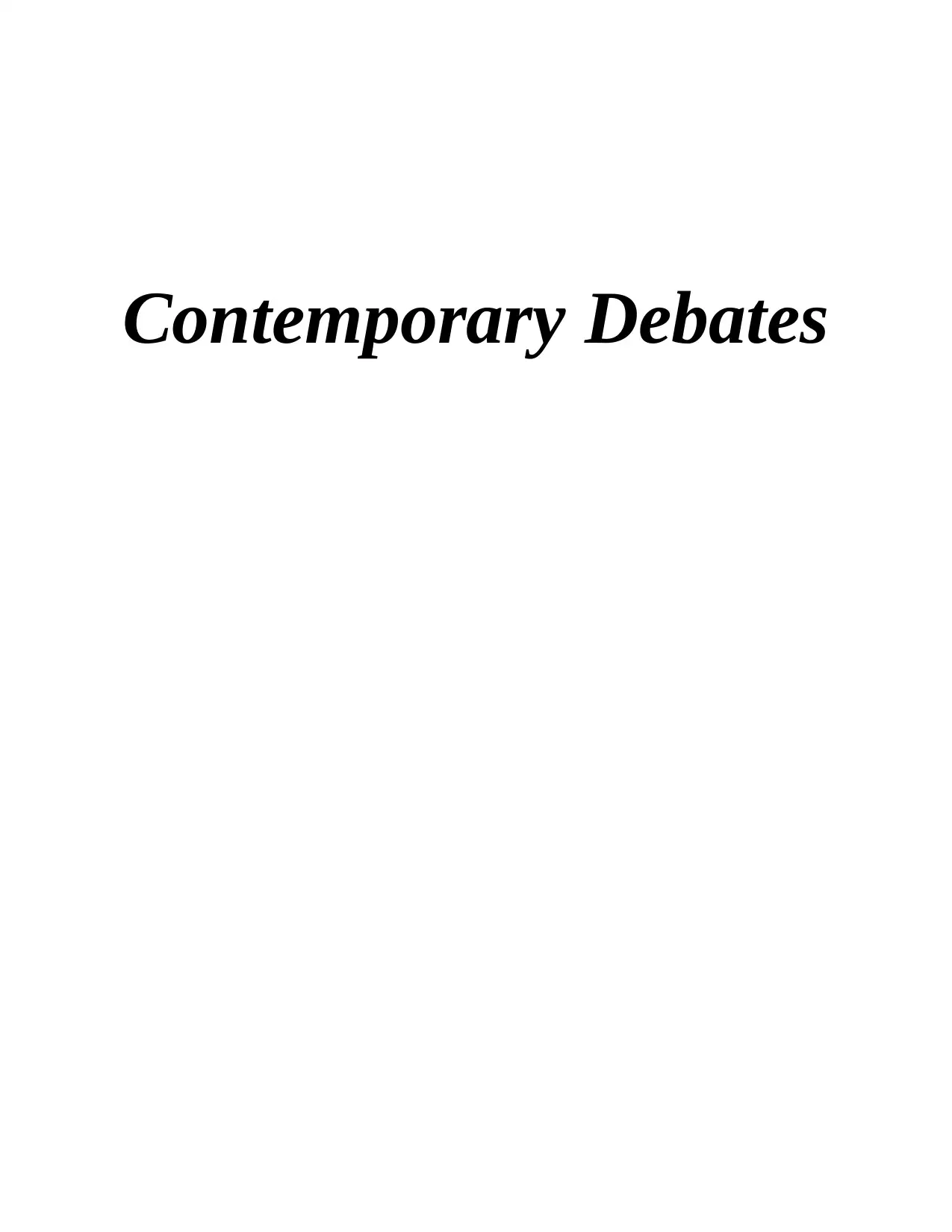
Contemporary Debates
Paraphrase This Document
Need a fresh take? Get an instant paraphrase of this document with our AI Paraphraser
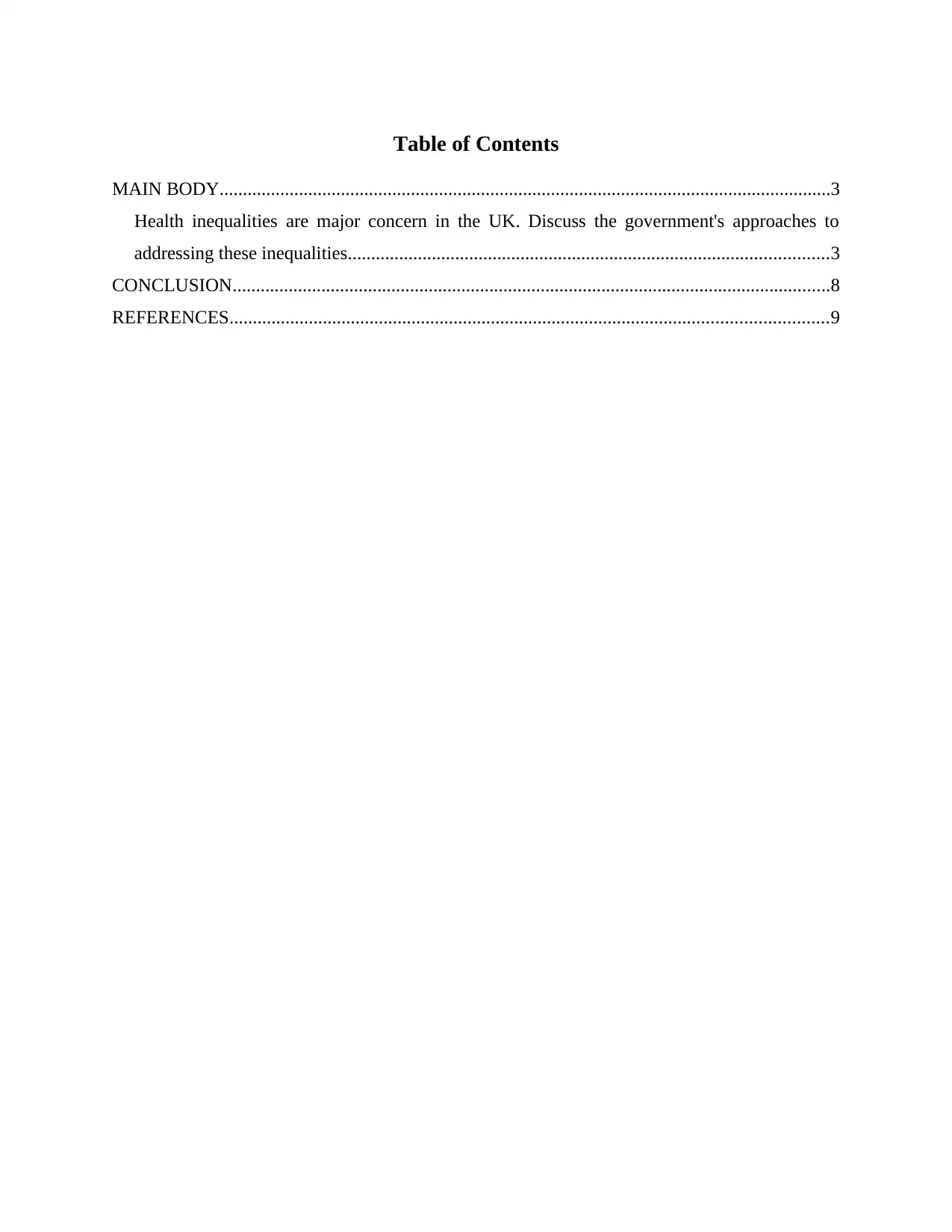
Table of Contents
MAIN BODY...................................................................................................................................3
Health inequalities are major concern in the UK. Discuss the government's approaches to
addressing these inequalities.......................................................................................................3
CONCLUSION................................................................................................................................8
REFERENCES................................................................................................................................9
MAIN BODY...................................................................................................................................3
Health inequalities are major concern in the UK. Discuss the government's approaches to
addressing these inequalities.......................................................................................................3
CONCLUSION................................................................................................................................8
REFERENCES................................................................................................................................9
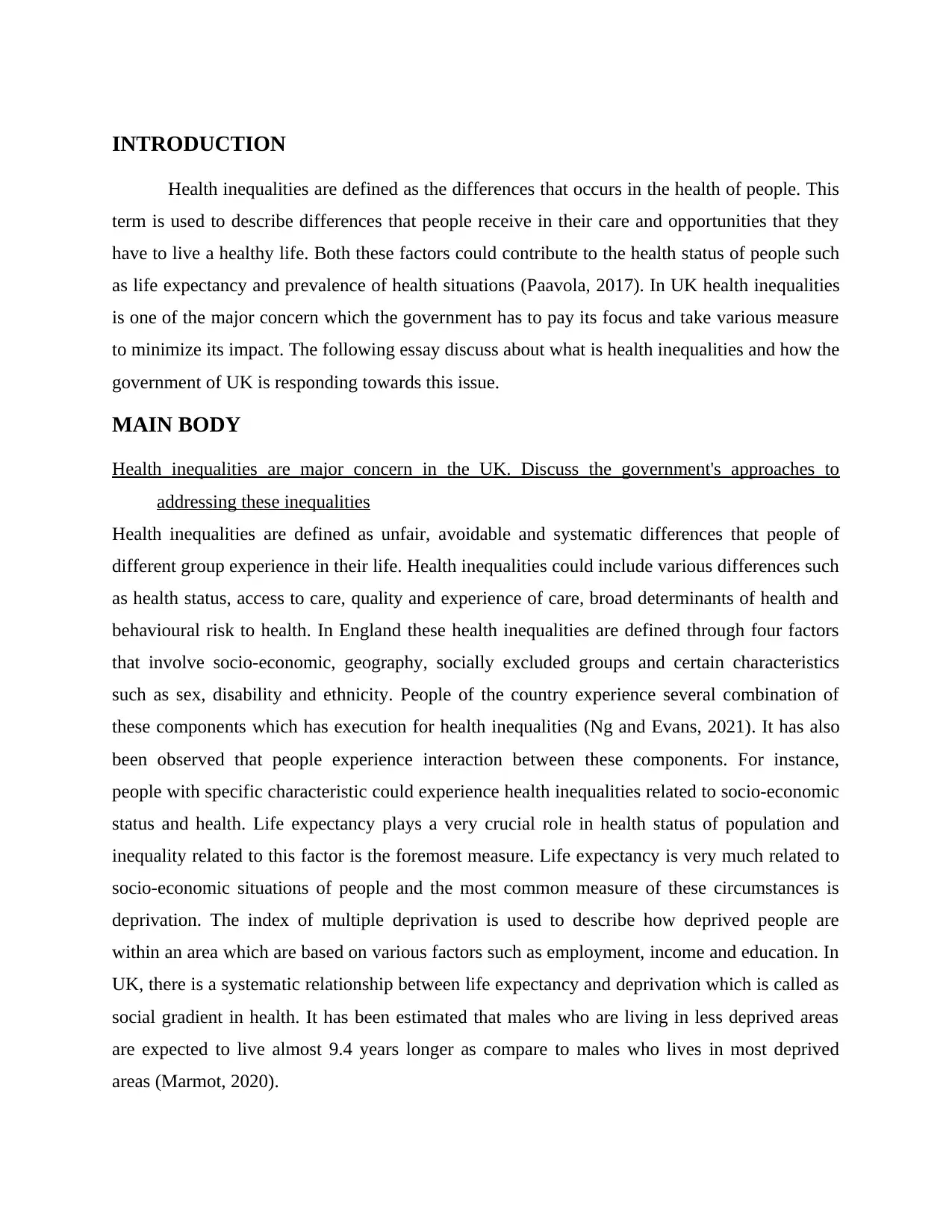
INTRODUCTION
Health inequalities are defined as the differences that occurs in the health of people. This
term is used to describe differences that people receive in their care and opportunities that they
have to live a healthy life. Both these factors could contribute to the health status of people such
as life expectancy and prevalence of health situations (Paavola, 2017). In UK health inequalities
is one of the major concern which the government has to pay its focus and take various measure
to minimize its impact. The following essay discuss about what is health inequalities and how the
government of UK is responding towards this issue.
MAIN BODY
Health inequalities are major concern in the UK. Discuss the government's approaches to
addressing these inequalities
Health inequalities are defined as unfair, avoidable and systematic differences that people of
different group experience in their life. Health inequalities could include various differences such
as health status, access to care, quality and experience of care, broad determinants of health and
behavioural risk to health. In England these health inequalities are defined through four factors
that involve socio-economic, geography, socially excluded groups and certain characteristics
such as sex, disability and ethnicity. People of the country experience several combination of
these components which has execution for health inequalities (Ng and Evans, 2021). It has also
been observed that people experience interaction between these components. For instance,
people with specific characteristic could experience health inequalities related to socio-economic
status and health. Life expectancy plays a very crucial role in health status of population and
inequality related to this factor is the foremost measure. Life expectancy is very much related to
socio-economic situations of people and the most common measure of these circumstances is
deprivation. The index of multiple deprivation is used to describe how deprived people are
within an area which are based on various factors such as employment, income and education. In
UK, there is a systematic relationship between life expectancy and deprivation which is called as
social gradient in health. It has been estimated that males who are living in less deprived areas
are expected to live almost 9.4 years longer as compare to males who lives in most deprived
areas (Marmot, 2020).
Health inequalities are defined as the differences that occurs in the health of people. This
term is used to describe differences that people receive in their care and opportunities that they
have to live a healthy life. Both these factors could contribute to the health status of people such
as life expectancy and prevalence of health situations (Paavola, 2017). In UK health inequalities
is one of the major concern which the government has to pay its focus and take various measure
to minimize its impact. The following essay discuss about what is health inequalities and how the
government of UK is responding towards this issue.
MAIN BODY
Health inequalities are major concern in the UK. Discuss the government's approaches to
addressing these inequalities
Health inequalities are defined as unfair, avoidable and systematic differences that people of
different group experience in their life. Health inequalities could include various differences such
as health status, access to care, quality and experience of care, broad determinants of health and
behavioural risk to health. In England these health inequalities are defined through four factors
that involve socio-economic, geography, socially excluded groups and certain characteristics
such as sex, disability and ethnicity. People of the country experience several combination of
these components which has execution for health inequalities (Ng and Evans, 2021). It has also
been observed that people experience interaction between these components. For instance,
people with specific characteristic could experience health inequalities related to socio-economic
status and health. Life expectancy plays a very crucial role in health status of population and
inequality related to this factor is the foremost measure. Life expectancy is very much related to
socio-economic situations of people and the most common measure of these circumstances is
deprivation. The index of multiple deprivation is used to describe how deprived people are
within an area which are based on various factors such as employment, income and education. In
UK, there is a systematic relationship between life expectancy and deprivation which is called as
social gradient in health. It has been estimated that males who are living in less deprived areas
are expected to live almost 9.4 years longer as compare to males who lives in most deprived
areas (Marmot, 2020).
⊘ This is a preview!⊘
Do you want full access?
Subscribe today to unlock all pages.

Trusted by 1+ million students worldwide
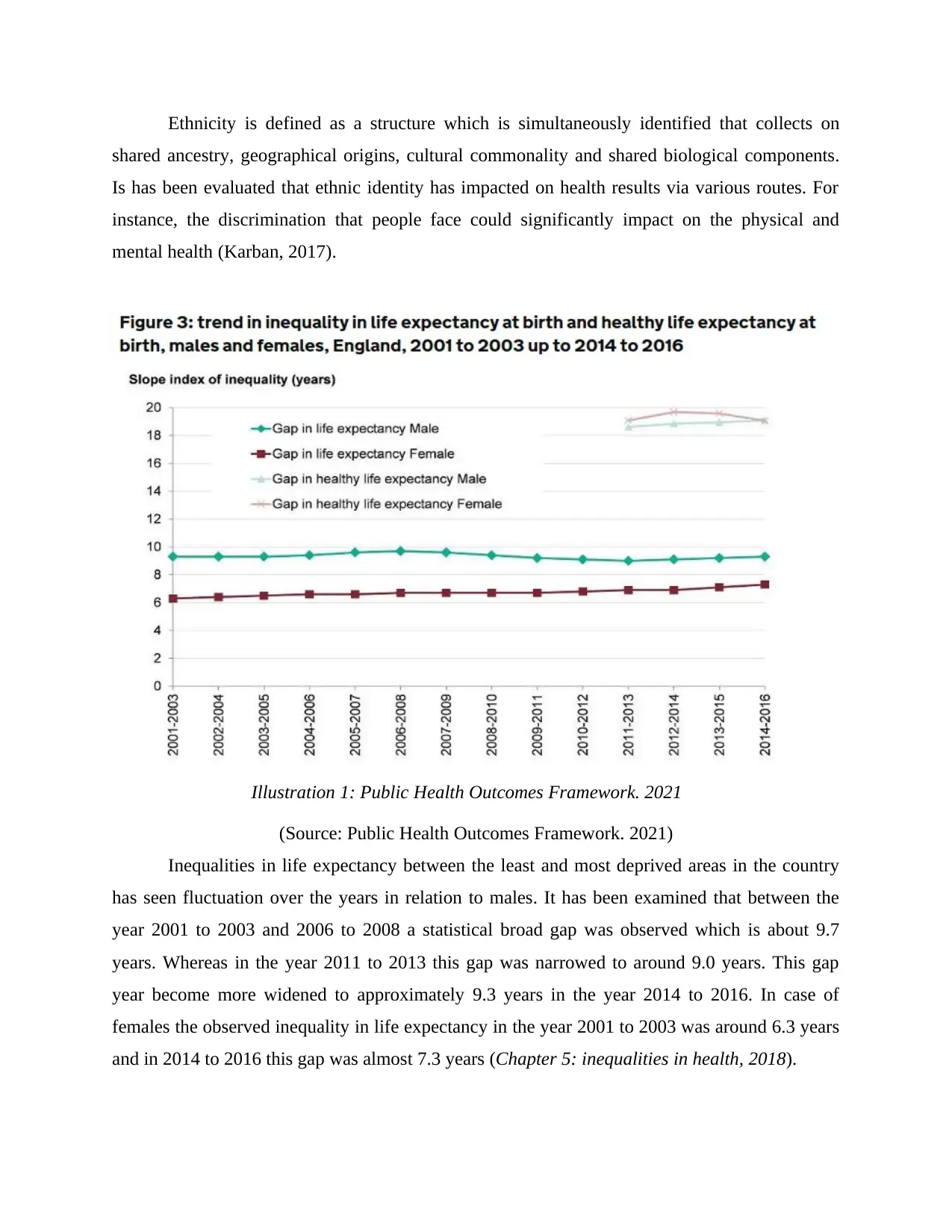
Ethnicity is defined as a structure which is simultaneously identified that collects on
shared ancestry, geographical origins, cultural commonality and shared biological components.
Is has been evaluated that ethnic identity has impacted on health results via various routes. For
instance, the discrimination that people face could significantly impact on the physical and
mental health (Karban, 2017).
(Source: Public Health Outcomes Framework. 2021)
Inequalities in life expectancy between the least and most deprived areas in the country
has seen fluctuation over the years in relation to males. It has been examined that between the
year 2001 to 2003 and 2006 to 2008 a statistical broad gap was observed which is about 9.7
years. Whereas in the year 2011 to 2013 this gap was narrowed to around 9.0 years. This gap
year become more widened to approximately 9.3 years in the year 2014 to 2016. In case of
females the observed inequality in life expectancy in the year 2001 to 2003 was around 6.3 years
and in 2014 to 2016 this gap was almost 7.3 years (Chapter 5: inequalities in health, 2018).
Illustration 1: Public Health Outcomes Framework. 2021
shared ancestry, geographical origins, cultural commonality and shared biological components.
Is has been evaluated that ethnic identity has impacted on health results via various routes. For
instance, the discrimination that people face could significantly impact on the physical and
mental health (Karban, 2017).
(Source: Public Health Outcomes Framework. 2021)
Inequalities in life expectancy between the least and most deprived areas in the country
has seen fluctuation over the years in relation to males. It has been examined that between the
year 2001 to 2003 and 2006 to 2008 a statistical broad gap was observed which is about 9.7
years. Whereas in the year 2011 to 2013 this gap was narrowed to around 9.0 years. This gap
year become more widened to approximately 9.3 years in the year 2014 to 2016. In case of
females the observed inequality in life expectancy in the year 2001 to 2003 was around 6.3 years
and in 2014 to 2016 this gap was almost 7.3 years (Chapter 5: inequalities in health, 2018).
Illustration 1: Public Health Outcomes Framework. 2021
Paraphrase This Document
Need a fresh take? Get an instant paraphrase of this document with our AI Paraphraser
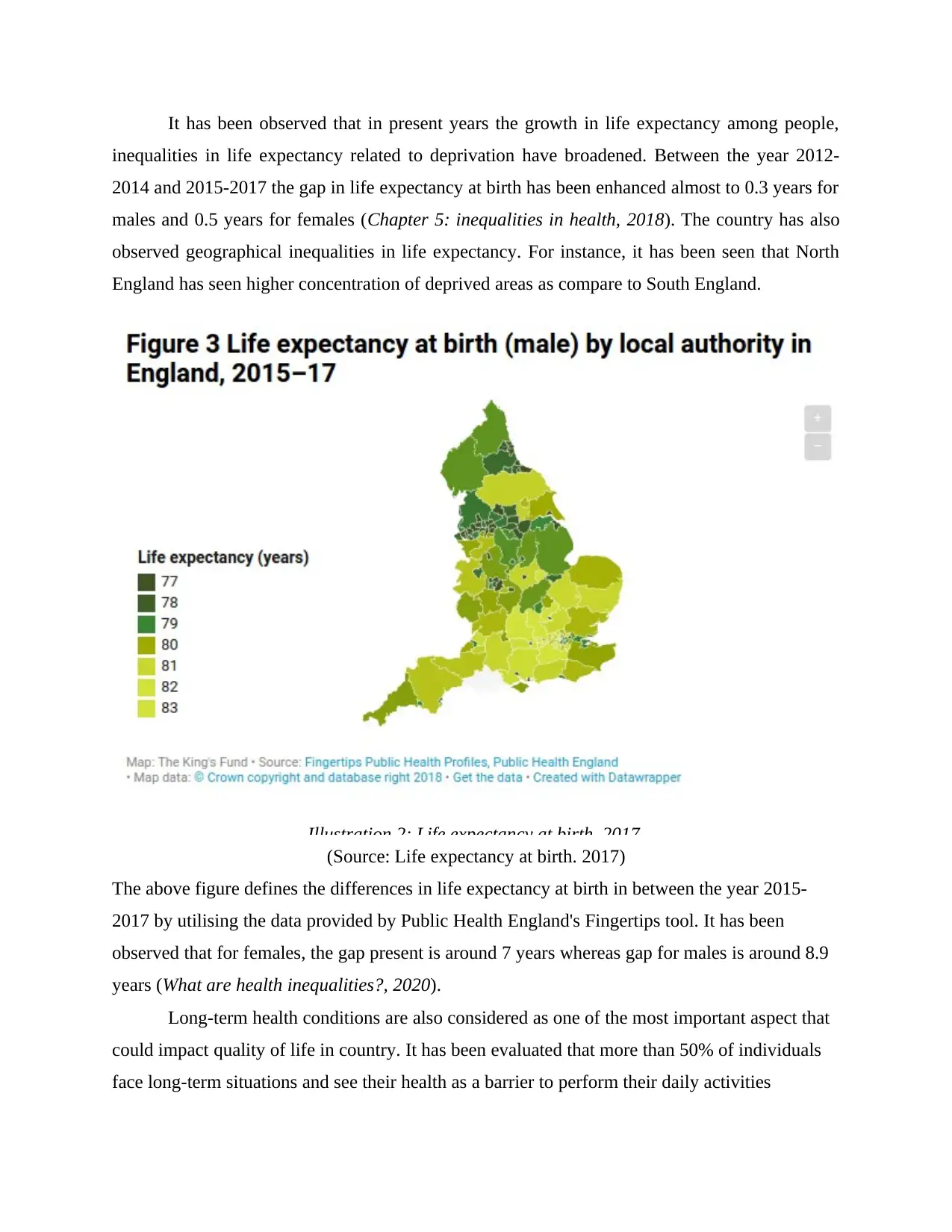
It has been observed that in present years the growth in life expectancy among people,
inequalities in life expectancy related to deprivation have broadened. Between the year 2012-
2014 and 2015-2017 the gap in life expectancy at birth has been enhanced almost to 0.3 years for
males and 0.5 years for females (Chapter 5: inequalities in health, 2018). The country has also
observed geographical inequalities in life expectancy. For instance, it has been seen that North
England has seen higher concentration of deprived areas as compare to South England.
(Source: Life expectancy at birth. 2017)
The above figure defines the differences in life expectancy at birth in between the year 2015-
2017 by utilising the data provided by Public Health England's Fingertips tool. It has been
observed that for females, the gap present is around 7 years whereas gap for males is around 8.9
years (What are health inequalities?, 2020).
Long-term health conditions are also considered as one of the most important aspect that
could impact quality of life in country. It has been evaluated that more than 50% of individuals
face long-term situations and see their health as a barrier to perform their daily activities
Illustration 2: Life expectancy at birth. 2017.
inequalities in life expectancy related to deprivation have broadened. Between the year 2012-
2014 and 2015-2017 the gap in life expectancy at birth has been enhanced almost to 0.3 years for
males and 0.5 years for females (Chapter 5: inequalities in health, 2018). The country has also
observed geographical inequalities in life expectancy. For instance, it has been seen that North
England has seen higher concentration of deprived areas as compare to South England.
(Source: Life expectancy at birth. 2017)
The above figure defines the differences in life expectancy at birth in between the year 2015-
2017 by utilising the data provided by Public Health England's Fingertips tool. It has been
observed that for females, the gap present is around 7 years whereas gap for males is around 8.9
years (What are health inequalities?, 2020).
Long-term health conditions are also considered as one of the most important aspect that
could impact quality of life in country. It has been evaluated that more than 50% of individuals
face long-term situations and see their health as a barrier to perform their daily activities
Illustration 2: Life expectancy at birth. 2017.
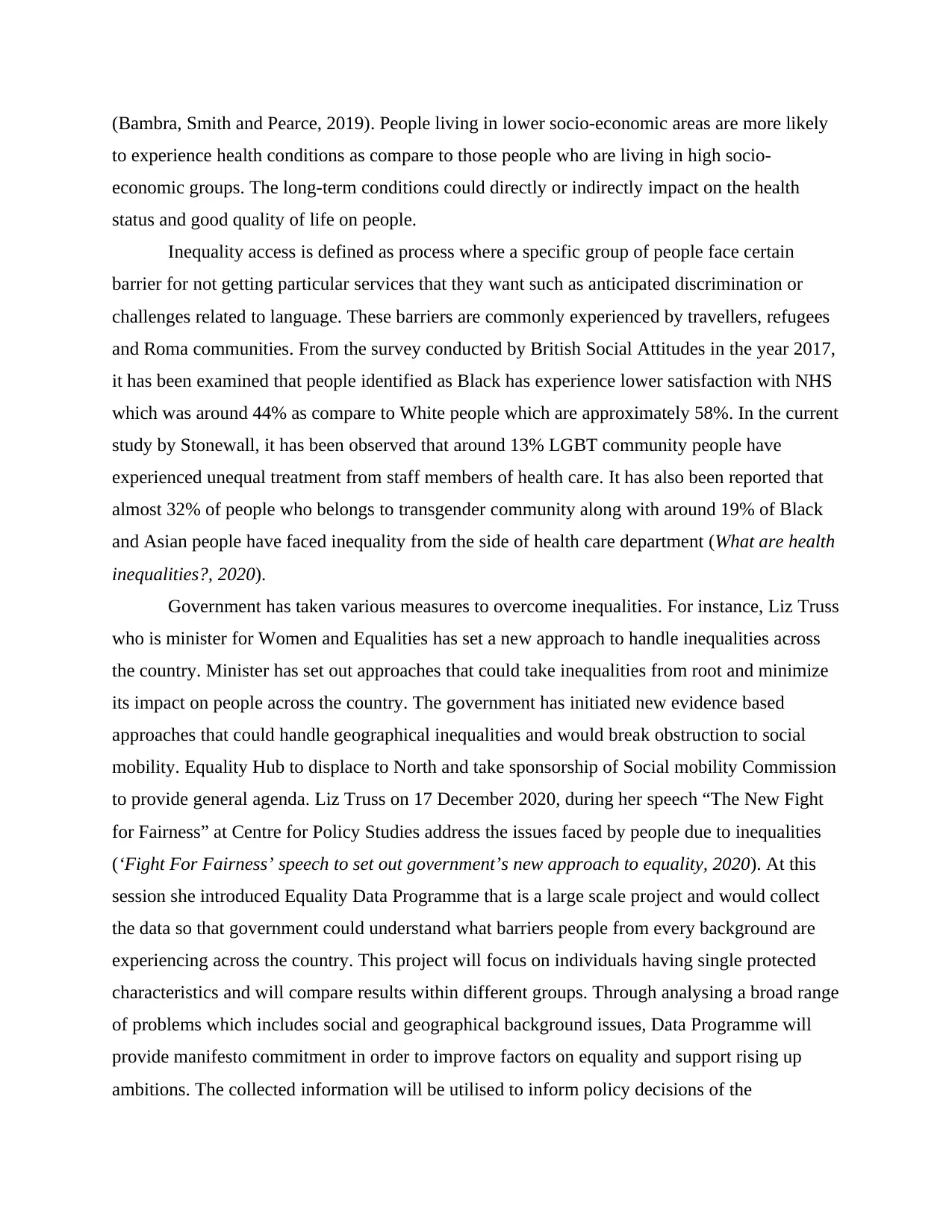
(Bambra, Smith and Pearce, 2019). People living in lower socio-economic areas are more likely
to experience health conditions as compare to those people who are living in high socio-
economic groups. The long-term conditions could directly or indirectly impact on the health
status and good quality of life on people.
Inequality access is defined as process where a specific group of people face certain
barrier for not getting particular services that they want such as anticipated discrimination or
challenges related to language. These barriers are commonly experienced by travellers, refugees
and Roma communities. From the survey conducted by British Social Attitudes in the year 2017,
it has been examined that people identified as Black has experience lower satisfaction with NHS
which was around 44% as compare to White people which are approximately 58%. In the current
study by Stonewall, it has been observed that around 13% LGBT community people have
experienced unequal treatment from staff members of health care. It has also been reported that
almost 32% of people who belongs to transgender community along with around 19% of Black
and Asian people have faced inequality from the side of health care department (What are health
inequalities?, 2020).
Government has taken various measures to overcome inequalities. For instance, Liz Truss
who is minister for Women and Equalities has set a new approach to handle inequalities across
the country. Minister has set out approaches that could take inequalities from root and minimize
its impact on people across the country. The government has initiated new evidence based
approaches that could handle geographical inequalities and would break obstruction to social
mobility. Equality Hub to displace to North and take sponsorship of Social mobility Commission
to provide general agenda. Liz Truss on 17 December 2020, during her speech “The New Fight
for Fairness” at Centre for Policy Studies address the issues faced by people due to inequalities
(‘Fight For Fairness’ speech to set out government’s new approach to equality, 2020). At this
session she introduced Equality Data Programme that is a large scale project and would collect
the data so that government could understand what barriers people from every background are
experiencing across the country. This project will focus on individuals having single protected
characteristics and will compare results within different groups. Through analysing a broad range
of problems which includes social and geographical background issues, Data Programme will
provide manifesto commitment in order to improve factors on equality and support rising up
ambitions. The collected information will be utilised to inform policy decisions of the
to experience health conditions as compare to those people who are living in high socio-
economic groups. The long-term conditions could directly or indirectly impact on the health
status and good quality of life on people.
Inequality access is defined as process where a specific group of people face certain
barrier for not getting particular services that they want such as anticipated discrimination or
challenges related to language. These barriers are commonly experienced by travellers, refugees
and Roma communities. From the survey conducted by British Social Attitudes in the year 2017,
it has been examined that people identified as Black has experience lower satisfaction with NHS
which was around 44% as compare to White people which are approximately 58%. In the current
study by Stonewall, it has been observed that around 13% LGBT community people have
experienced unequal treatment from staff members of health care. It has also been reported that
almost 32% of people who belongs to transgender community along with around 19% of Black
and Asian people have faced inequality from the side of health care department (What are health
inequalities?, 2020).
Government has taken various measures to overcome inequalities. For instance, Liz Truss
who is minister for Women and Equalities has set a new approach to handle inequalities across
the country. Minister has set out approaches that could take inequalities from root and minimize
its impact on people across the country. The government has initiated new evidence based
approaches that could handle geographical inequalities and would break obstruction to social
mobility. Equality Hub to displace to North and take sponsorship of Social mobility Commission
to provide general agenda. Liz Truss on 17 December 2020, during her speech “The New Fight
for Fairness” at Centre for Policy Studies address the issues faced by people due to inequalities
(‘Fight For Fairness’ speech to set out government’s new approach to equality, 2020). At this
session she introduced Equality Data Programme that is a large scale project and would collect
the data so that government could understand what barriers people from every background are
experiencing across the country. This project will focus on individuals having single protected
characteristics and will compare results within different groups. Through analysing a broad range
of problems which includes social and geographical background issues, Data Programme will
provide manifesto commitment in order to improve factors on equality and support rising up
ambitions. The collected information will be utilised to inform policy decisions of the
⊘ This is a preview!⊘
Do you want full access?
Subscribe today to unlock all pages.

Trusted by 1+ million students worldwide
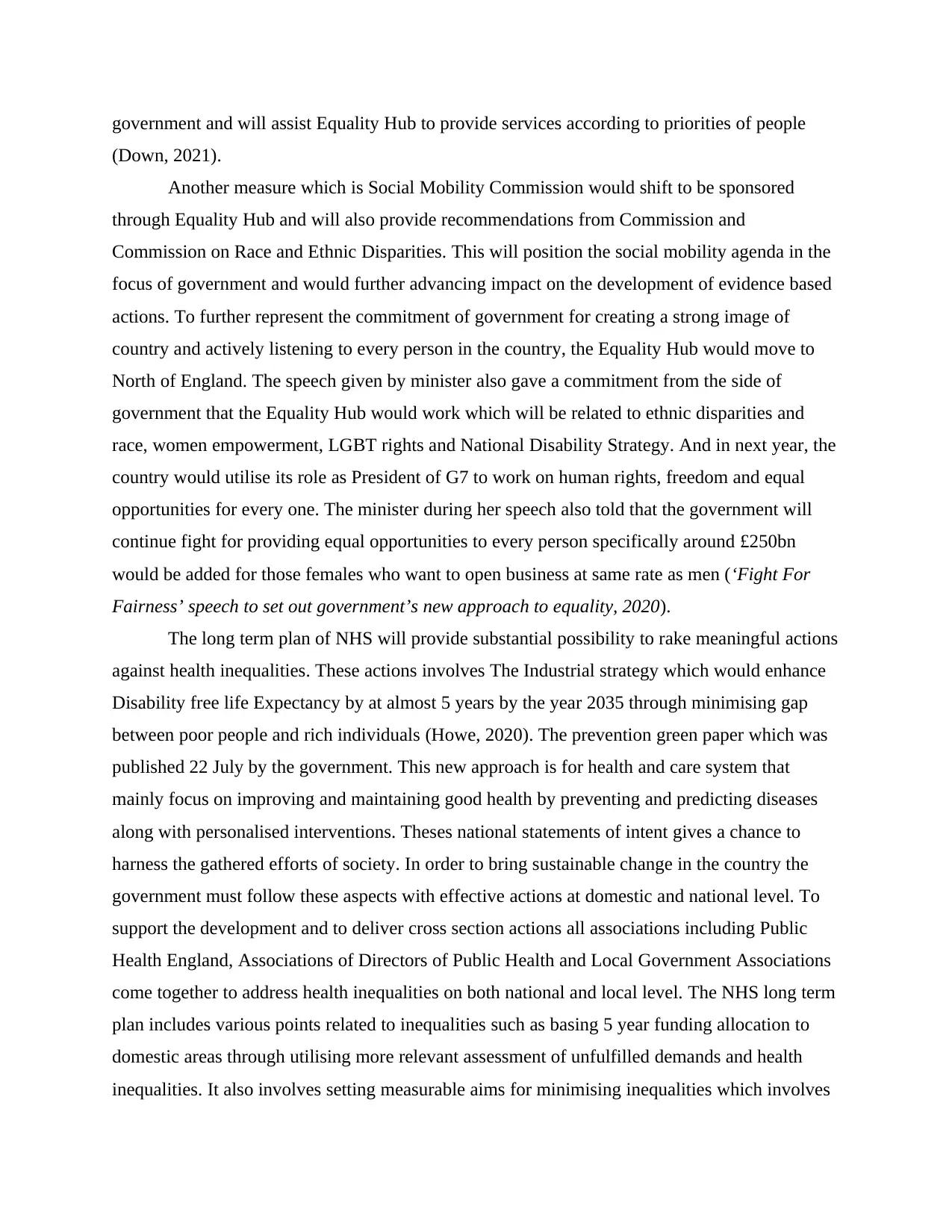
government and will assist Equality Hub to provide services according to priorities of people
(Down, 2021).
Another measure which is Social Mobility Commission would shift to be sponsored
through Equality Hub and will also provide recommendations from Commission and
Commission on Race and Ethnic Disparities. This will position the social mobility agenda in the
focus of government and would further advancing impact on the development of evidence based
actions. To further represent the commitment of government for creating a strong image of
country and actively listening to every person in the country, the Equality Hub would move to
North of England. The speech given by minister also gave a commitment from the side of
government that the Equality Hub would work which will be related to ethnic disparities and
race, women empowerment, LGBT rights and National Disability Strategy. And in next year, the
country would utilise its role as President of G7 to work on human rights, freedom and equal
opportunities for every one. The minister during her speech also told that the government will
continue fight for providing equal opportunities to every person specifically around £250bn
would be added for those females who want to open business at same rate as men (‘Fight For
Fairness’ speech to set out government’s new approach to equality, 2020).
The long term plan of NHS will provide substantial possibility to rake meaningful actions
against health inequalities. These actions involves The Industrial strategy which would enhance
Disability free life Expectancy by at almost 5 years by the year 2035 through minimising gap
between poor people and rich individuals (Howe, 2020). The prevention green paper which was
published 22 July by the government. This new approach is for health and care system that
mainly focus on improving and maintaining good health by preventing and predicting diseases
along with personalised interventions. Theses national statements of intent gives a chance to
harness the gathered efforts of society. In order to bring sustainable change in the country the
government must follow these aspects with effective actions at domestic and national level. To
support the development and to deliver cross section actions all associations including Public
Health England, Associations of Directors of Public Health and Local Government Associations
come together to address health inequalities on both national and local level. The NHS long term
plan includes various points related to inequalities such as basing 5 year funding allocation to
domestic areas through utilising more relevant assessment of unfulfilled demands and health
inequalities. It also involves setting measurable aims for minimising inequalities which involves
(Down, 2021).
Another measure which is Social Mobility Commission would shift to be sponsored
through Equality Hub and will also provide recommendations from Commission and
Commission on Race and Ethnic Disparities. This will position the social mobility agenda in the
focus of government and would further advancing impact on the development of evidence based
actions. To further represent the commitment of government for creating a strong image of
country and actively listening to every person in the country, the Equality Hub would move to
North of England. The speech given by minister also gave a commitment from the side of
government that the Equality Hub would work which will be related to ethnic disparities and
race, women empowerment, LGBT rights and National Disability Strategy. And in next year, the
country would utilise its role as President of G7 to work on human rights, freedom and equal
opportunities for every one. The minister during her speech also told that the government will
continue fight for providing equal opportunities to every person specifically around £250bn
would be added for those females who want to open business at same rate as men (‘Fight For
Fairness’ speech to set out government’s new approach to equality, 2020).
The long term plan of NHS will provide substantial possibility to rake meaningful actions
against health inequalities. These actions involves The Industrial strategy which would enhance
Disability free life Expectancy by at almost 5 years by the year 2035 through minimising gap
between poor people and rich individuals (Howe, 2020). The prevention green paper which was
published 22 July by the government. This new approach is for health and care system that
mainly focus on improving and maintaining good health by preventing and predicting diseases
along with personalised interventions. Theses national statements of intent gives a chance to
harness the gathered efforts of society. In order to bring sustainable change in the country the
government must follow these aspects with effective actions at domestic and national level. To
support the development and to deliver cross section actions all associations including Public
Health England, Associations of Directors of Public Health and Local Government Associations
come together to address health inequalities on both national and local level. The NHS long term
plan includes various points related to inequalities such as basing 5 year funding allocation to
domestic areas through utilising more relevant assessment of unfulfilled demands and health
inequalities. It also involves setting measurable aims for minimising inequalities which involves
Paraphrase This Document
Need a fresh take? Get an instant paraphrase of this document with our AI Paraphraser
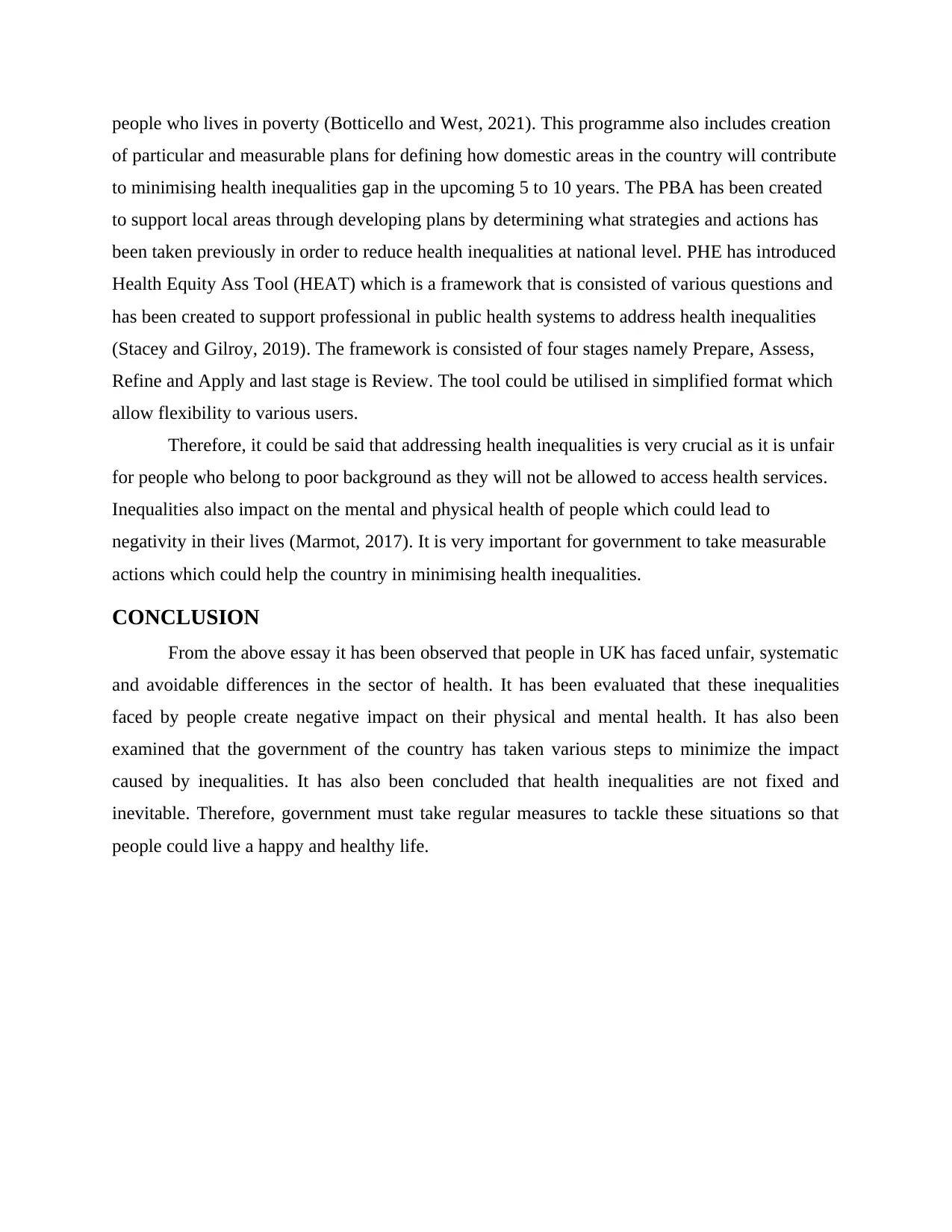
people who lives in poverty (Botticello and West, 2021). This programme also includes creation
of particular and measurable plans for defining how domestic areas in the country will contribute
to minimising health inequalities gap in the upcoming 5 to 10 years. The PBA has been created
to support local areas through developing plans by determining what strategies and actions has
been taken previously in order to reduce health inequalities at national level. PHE has introduced
Health Equity Ass Tool (HEAT) which is a framework that is consisted of various questions and
has been created to support professional in public health systems to address health inequalities
(Stacey and Gilroy, 2019). The framework is consisted of four stages namely Prepare, Assess,
Refine and Apply and last stage is Review. The tool could be utilised in simplified format which
allow flexibility to various users.
Therefore, it could be said that addressing health inequalities is very crucial as it is unfair
for people who belong to poor background as they will not be allowed to access health services.
Inequalities also impact on the mental and physical health of people which could lead to
negativity in their lives (Marmot, 2017). It is very important for government to take measurable
actions which could help the country in minimising health inequalities.
CONCLUSION
From the above essay it has been observed that people in UK has faced unfair, systematic
and avoidable differences in the sector of health. It has been evaluated that these inequalities
faced by people create negative impact on their physical and mental health. It has also been
examined that the government of the country has taken various steps to minimize the impact
caused by inequalities. It has also been concluded that health inequalities are not fixed and
inevitable. Therefore, government must take regular measures to tackle these situations so that
people could live a happy and healthy life.
of particular and measurable plans for defining how domestic areas in the country will contribute
to minimising health inequalities gap in the upcoming 5 to 10 years. The PBA has been created
to support local areas through developing plans by determining what strategies and actions has
been taken previously in order to reduce health inequalities at national level. PHE has introduced
Health Equity Ass Tool (HEAT) which is a framework that is consisted of various questions and
has been created to support professional in public health systems to address health inequalities
(Stacey and Gilroy, 2019). The framework is consisted of four stages namely Prepare, Assess,
Refine and Apply and last stage is Review. The tool could be utilised in simplified format which
allow flexibility to various users.
Therefore, it could be said that addressing health inequalities is very crucial as it is unfair
for people who belong to poor background as they will not be allowed to access health services.
Inequalities also impact on the mental and physical health of people which could lead to
negativity in their lives (Marmot, 2017). It is very important for government to take measurable
actions which could help the country in minimising health inequalities.
CONCLUSION
From the above essay it has been observed that people in UK has faced unfair, systematic
and avoidable differences in the sector of health. It has been evaluated that these inequalities
faced by people create negative impact on their physical and mental health. It has also been
examined that the government of the country has taken various steps to minimize the impact
caused by inequalities. It has also been concluded that health inequalities are not fixed and
inevitable. Therefore, government must take regular measures to tackle these situations so that
people could live a happy and healthy life.
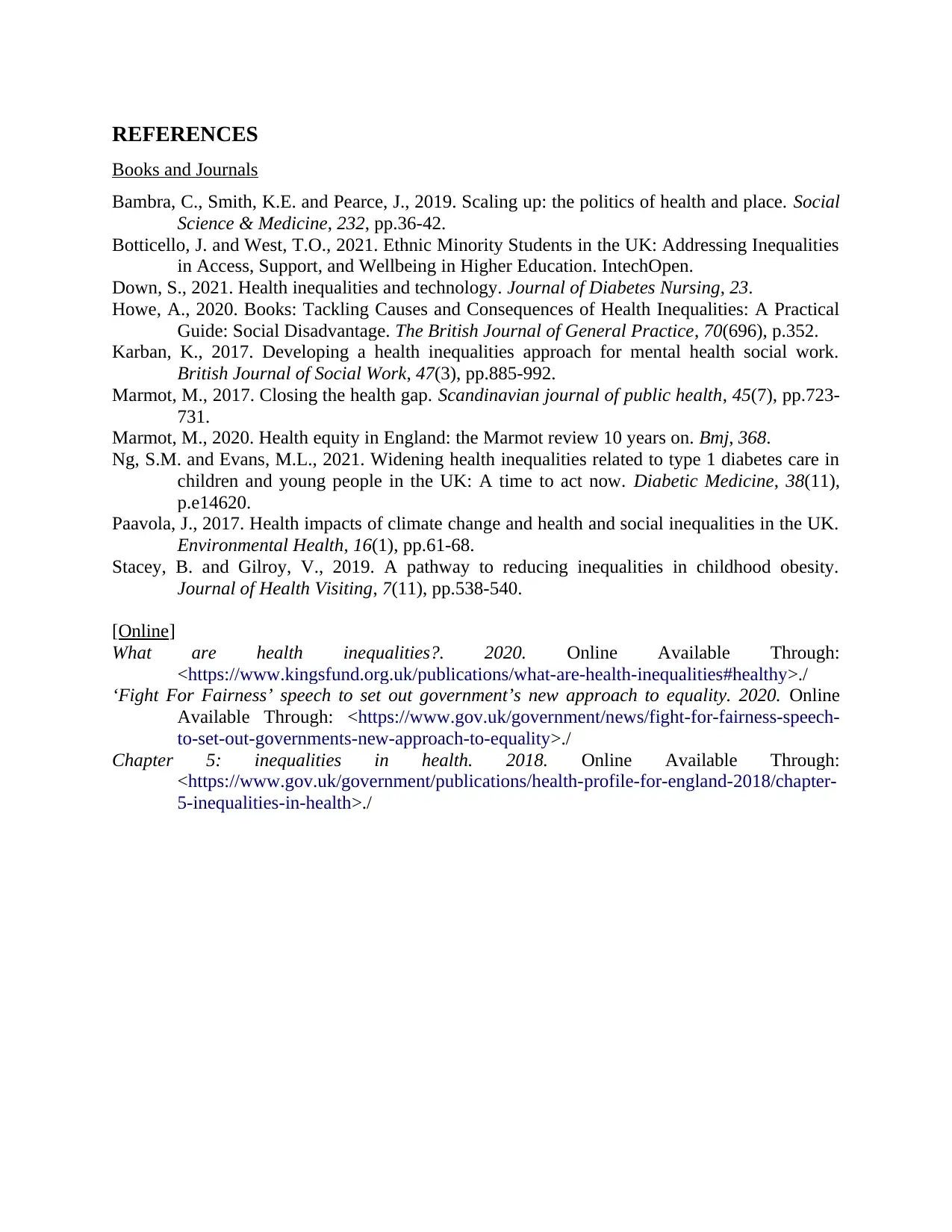
REFERENCES
Books and Journals
Bambra, C., Smith, K.E. and Pearce, J., 2019. Scaling up: the politics of health and place. Social
Science & Medicine, 232, pp.36-42.
Botticello, J. and West, T.O., 2021. Ethnic Minority Students in the UK: Addressing Inequalities
in Access, Support, and Wellbeing in Higher Education. IntechOpen.
Down, S., 2021. Health inequalities and technology. Journal of Diabetes Nursing, 23.
Howe, A., 2020. Books: Tackling Causes and Consequences of Health Inequalities: A Practical
Guide: Social Disadvantage. The British Journal of General Practice, 70(696), p.352.
Karban, K., 2017. Developing a health inequalities approach for mental health social work.
British Journal of Social Work, 47(3), pp.885-992.
Marmot, M., 2017. Closing the health gap. Scandinavian journal of public health, 45(7), pp.723-
731.
Marmot, M., 2020. Health equity in England: the Marmot review 10 years on. Bmj, 368.
Ng, S.M. and Evans, M.L., 2021. Widening health inequalities related to type 1 diabetes care in
children and young people in the UK: A time to act now. Diabetic Medicine, 38(11),
p.e14620.
Paavola, J., 2017. Health impacts of climate change and health and social inequalities in the UK.
Environmental Health, 16(1), pp.61-68.
Stacey, B. and Gilroy, V., 2019. A pathway to reducing inequalities in childhood obesity.
Journal of Health Visiting, 7(11), pp.538-540.
[Online]
What are health inequalities?. 2020. Online Available Through:
<https://www.kingsfund.org.uk/publications/what-are-health-inequalities#healthy>./
‘Fight For Fairness’ speech to set out government’s new approach to equality. 2020. Online
Available Through: <https://www.gov.uk/government/news/fight-for-fairness-speech-
to-set-out-governments-new-approach-to-equality>./
Chapter 5: inequalities in health. 2018. Online Available Through:
<https://www.gov.uk/government/publications/health-profile-for-england-2018/chapter-
5-inequalities-in-health>./
Books and Journals
Bambra, C., Smith, K.E. and Pearce, J., 2019. Scaling up: the politics of health and place. Social
Science & Medicine, 232, pp.36-42.
Botticello, J. and West, T.O., 2021. Ethnic Minority Students in the UK: Addressing Inequalities
in Access, Support, and Wellbeing in Higher Education. IntechOpen.
Down, S., 2021. Health inequalities and technology. Journal of Diabetes Nursing, 23.
Howe, A., 2020. Books: Tackling Causes and Consequences of Health Inequalities: A Practical
Guide: Social Disadvantage. The British Journal of General Practice, 70(696), p.352.
Karban, K., 2017. Developing a health inequalities approach for mental health social work.
British Journal of Social Work, 47(3), pp.885-992.
Marmot, M., 2017. Closing the health gap. Scandinavian journal of public health, 45(7), pp.723-
731.
Marmot, M., 2020. Health equity in England: the Marmot review 10 years on. Bmj, 368.
Ng, S.M. and Evans, M.L., 2021. Widening health inequalities related to type 1 diabetes care in
children and young people in the UK: A time to act now. Diabetic Medicine, 38(11),
p.e14620.
Paavola, J., 2017. Health impacts of climate change and health and social inequalities in the UK.
Environmental Health, 16(1), pp.61-68.
Stacey, B. and Gilroy, V., 2019. A pathway to reducing inequalities in childhood obesity.
Journal of Health Visiting, 7(11), pp.538-540.
[Online]
What are health inequalities?. 2020. Online Available Through:
<https://www.kingsfund.org.uk/publications/what-are-health-inequalities#healthy>./
‘Fight For Fairness’ speech to set out government’s new approach to equality. 2020. Online
Available Through: <https://www.gov.uk/government/news/fight-for-fairness-speech-
to-set-out-governments-new-approach-to-equality>./
Chapter 5: inequalities in health. 2018. Online Available Through:
<https://www.gov.uk/government/publications/health-profile-for-england-2018/chapter-
5-inequalities-in-health>./
⊘ This is a preview!⊘
Do you want full access?
Subscribe today to unlock all pages.

Trusted by 1+ million students worldwide
1 out of 9
Related Documents
Your All-in-One AI-Powered Toolkit for Academic Success.
+13062052269
info@desklib.com
Available 24*7 on WhatsApp / Email
![[object Object]](/_next/static/media/star-bottom.7253800d.svg)
Unlock your academic potential
Copyright © 2020–2025 A2Z Services. All Rights Reserved. Developed and managed by ZUCOL.





